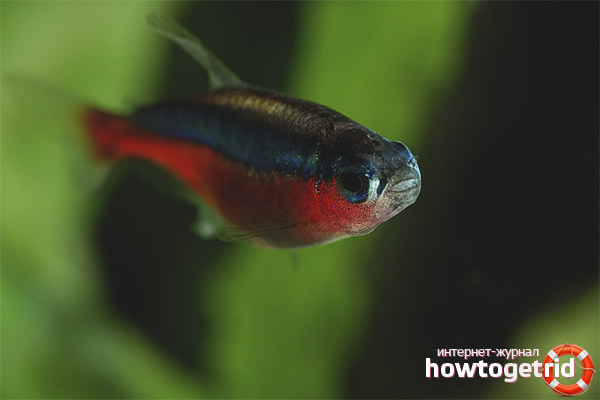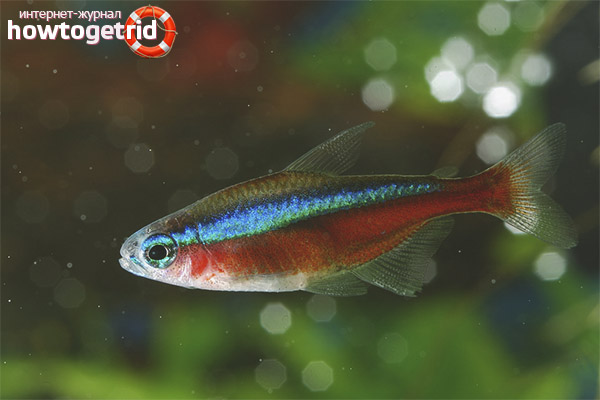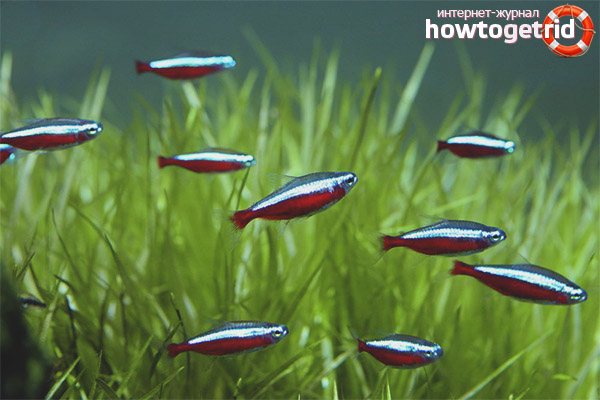The content of the article
Red neon is an unusual variety of fish that is very popular among aquarists. These fish look especially beautiful when they swim in groups. Many professional breeders of such fish equip for them an aquarium with a large variety of plants. In such decorations, red neon looks even more bewitching.
You can recognize these fish by the blue strip located in the middle of the body, as well as the red strip passing from the bottom. The second strip of red is present only in neons of this species, and therefore is their distinguishing feature. For example, ordinary neon no longer has such a feature. Moreover, red neons are larger, which also distinguishes them from other species of fish.
Such beauty has some consequences. The fact is that these fish are more capricious and demanding regarding the living conditions in a home aquarium. In addition, in comparison with other aquarium inhabitants, red neon is small in size, and therefore can suffer from larger individuals. By nature, these beautiful fish are quite peaceful.
It is worth noting that the color of red neon becomes deeper and more pronounced if it is kept in a container filled with sufficiently acidic, and most importantly, soft water. In a well-equipped space with suitable conditions, red neon lives well and resists perfectly with various diseases. However, if these individuals are not provided with the necessary conditions, they can die very quickly. Like many other representatives of neon, red neon often suffer from neon disease. The main signs of this ailment is a change in color - it becomes more pale and dull. In addition, individuals dramatically lose weight, become very thin, and then die. Unfortunately for many aquarists, it is impossible to cure fish with such a disease.
Life in the wild
In pet stores, they mostly sell fish that are artificially bred in our country. From nature, quite a few individuals fall onto store shelves.
View characteristics
Compared to other fish, red neons are quite small, in length they reach only 5 centimeters. These fish also have a short life expectancy in comparison with other aquarium inhabitants, on average they live only about 3 years. Outwardly, neon red is similar to neons of a usual kind, they are distinguished only by a red strip on the body. In ordinary neons, it reaches only the middle of the abdomen, while in red neon, the strip passes throughout the body.
What difficulties may arise in the content?

In content, red neon is a rather complex and demanding fish.It should be looked after more carefully than even ordinary neon. These fish are very sensitive to all indicators of water. If the temperature, acidity and hardness of water are constantly changing, such conditions for red neon will be fatal. Such individuals are best wound up by aquarists with sufficient experience, as red neons often die in novice breeders.
How to feed red neon?
Despite some difficulties in keeping, the red neons are very unpretentious in eating. They can be fed with almost any kind of food: live food, frozen food, as well as dry foods. The only thing that is important for individuals of this species is the small size of the feed, as these fish have a small mouth. Moths and pipe makers become a favorite treat for red neons. The diet of red neon should be varied. This condition is perhaps the main for normal and healthy growth, maintaining a bright color, as well as active life of the fish. It is not recommended for a long time to feed the fish with the same food. Of particular concern is the frequent feeding of dry foods, in particular dried gammarus and daphnia.
What is the best way to keep at home?
For red neon, it is extremely important that the water is non-rigid and have stable performance. The acidity of the water should not exceed 6 units, and the water hardness should preferably be no more than 4 units. By the appearance of red neon, one can understand how suitable the conditions are for him. For example, in too hard water the color fades. In addition, these parameters affect the life expectancy of fish. The ideal temperature for red neon is an indicator in the range from 23 to 27 degrees. The most important thing in this case is to ensure the stability of all water indicators, since neons do not survive any serious leaps well.
Red neons do not need bright light, for this reason it is advisable to fill the aquarium with a large number of plants. Floating plants are great for these fish, as they create good shade. However, do not overdo it with plants, because neons also need a place in order to swim freely. You can place plants on the walls of the aquarium, and leave the middle for swimming. An aquarium that is too large is not required. A capacity of about 70 liters will be sufficient for 6-7 fish.
How do neons live with other aquarium inhabitants?
Breeding offspring
The spread of red neon is not always given even to very experienced specialists. For this purpose, another container with the same stable fluid performance is needed. In this aquarium, special conditions must also be organized: a sufficient number of plants. Red neons produce eggs mainly in the evening or at night, as the larvae are very sensitive to light. As a rule, the female places the obtained eggs on the leaves of plants. Since fish can eat their future offspring, it is necessary to remove them from the aquarium after spawning. A day after spawning, it will be possible to notice how the larva hatch, and then, after another three days, the larva will turn into fry.
Video: red neon aquarium fish











Submit